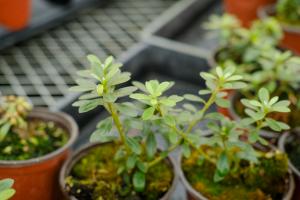Introduction
The banyan tree is a large, majestic tree that can be found in different parts of the world. It is known for its ability to grow wide as its branches extend outwards and downwards, forming aerial roots that give the tree a unique appearance. In this article, we will explore the different types of banyan trees and their characteristics.
Types of Banyan Trees
There are several types of banyan trees, with the most popular being the Indian banyan (Ficus benghalensis). This type of banyan tree is native to the Indian subcontinent and is widely distributed throughout the region. The Indian banyan can grow up to 30 meters tall and can have a canopy that extends over 200 meters. It has a thick trunk with aerial roots that grow downwards to the ground, forming additional support for the tree.
Another type of banyan tree is the Chinese banyan (Ficus microcarpa), which is native to Southeast Asia, and Southern China. This type of banyan tree is smaller in size, reaching up to 15 meters tall, and has a thinner trunk compared to the Indian banyan. Its aerial roots are also thinner and more delicate in appearance, with smaller leaves that are more symmetrical in shape.
The strangler fig (Ficus aurea) is another type of banyan tree that is native to Florida and the Caribbean. It grows by starting as an epiphyte on another tree, gradually enveloping it with its aerial roots until it becomes the main trunk of the tree. The strangler fig is considered to be a powerful symbol of ecological succession, as it plays an important role in transforming disturbed habitats into mature forests.
Characteristics of Banyan Trees
Banyan trees are known for their unique aerial roots, which can grow downwards towards the ground or extend horizontally, forming a wide network of roots that can cover a large area. These aerial roots can act as natural supports for the tree, and can also absorb moisture and nutrients from the ground. The roots of banyan trees are considered to be an important feature of the tree, as they give it a distinctive appearance and provide additional protection against natural disasters such as storms and floods.
Banyan trees also have large, flat and glossy leaves that can reach up to 30 centimeters in length. The leaves have a leathery texture, which allows them to withstand high temperatures and strong winds. Banyan trees can also produce figs, which are a type of fruit that are considered to be an important food source for many animals, including birds and monkeys.
Cultural Significance of Banyan Trees
Banyan trees have been revered in many cultures for their resilience and beauty. In Hinduism, the banyan tree is considered to be a sacred tree and is associated with the god Shiva. According to Hindu mythology, the banyan tree is the resting place of the spirits of the ancestors, providing a link between the living and the dead.
In Buddhism, the banyan tree is considered to be a symbol of the Buddha's enlightenment, as it is believed that the Buddha meditated under a banyan tree for seven days after he attained enlightenment.
The banyan tree is also considered to be a symbol of growth and renewal in many cultures. It is seen as a source of strength and resilience in the face of adversity, and is often associated with the idea of rebirth and new beginnings.
Conclusion
The banyan tree is a fascinating and beautiful tree that has captured the imaginations of people all over the world. With its unique appearance and cultural significance, the banyan tree is a true wonder of nature that continues to inspire awe and admiration in those who encounter it.

 how many times do yo...
how many times do yo... how many planted tre...
how many planted tre... how many pine trees ...
how many pine trees ... how many pecan trees...
how many pecan trees... how many plants comp...
how many plants comp... how many plants can ...
how many plants can ... how many plants and ...
how many plants and ... how many pepper plan...
how many pepper plan...































